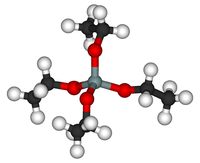Tetraethyl orthosilicate
 |
|
 |
|
| Names | |
|---|---|
|
IUPAC name
tetraethoxysilane
|
|
| Other names
tetraethyl orthosilicate; ethyl silicate; silicic acid tetraethyl ester; silicon ethoxide; TEOS; tetraethyl silicate
|
|
| Identifiers | |
|
3D model (Jmol)
|
|
| ChemSpider | |
| ECHA InfoCard | 100.000.986 |
|
PubChem CID
|
|
| UNII | |
|
|
|
|
| Properties | |
| SiC8H20O4 | |
| Molar mass | 208.33 g mol−1 |
| Appearance | colourless liquid |
| Odor | sharp, alcohol-like |
| Density | 0.933 g/mL at 20 °C |
| Melting point | −77 °C (−107 °F; 196 K) |
| Boiling point | 168 to 169 °C (334 to 336 °F; 441 to 442 K) |
| reacts with water, soluble in ethanol, and 2-propanol | |
| Vapor pressure | 1 mmHg |
| Hazards | |
| Main hazards | Flammable, Harmful by inhalation |
| Flash point | 45 °C (113 °F; 318 K) |
| Lethal dose or concentration (LD, LC): | |
|
LD50 (median dose)
|
6270 mg/kg (rat, oral) |
|
LCLo (lowest published)
|
1000 ppm (rat, 4 hr) 700 ppm (guinea pig, 6 hr) 1740 ppm (guinea pig, 15 min) 1170 ppm (guinea pig, 2 hr) |
| US health exposure limits (NIOSH): | |
|
PEL (Permissible)
|
TWA 100 ppm (850 mg/m3) |
|
REL (Recommended)
|
TWA 10 ppm (85 mg/m3) |
|
IDLH (Immediate danger)
|
700 ppm |
|
Except where otherwise noted, data are given for materials in their standard state (at 25 °C [77 °F], 100 kPa).
|
|
|
|
|
| Infobox references | |
Tetraethyl orthosilicate, formally named tetraethoxysilane, is the chemical compound with the formula Si(OC2H5)4. Often abbreviated TEOS, it is a colorless liquid that degrades in water. TEOS is the ethyl ester of orthosilicic acid, Si(OH)4. It is the most prevalent alkoxide of silicon.
TEOS is a tetrahedral molecule. Like its many analogues, it is prepared by alcoholysis of silicon tetrachloride:
where Et is the ethyl radical, C2H5, and thus EtOH is ethanol.
TEOS is mainly used as a crosslinking agent in silicone polymers and as a precursor to silicon dioxide in the semiconductor industry. TEOS is also used as the silica source for synthesis of some zeolites. Other applications include coatings for carpets and other objects. TEOS is used in the production of aerogel. These applications exploit the reactivity of the Si-OR bonds.
TEOS easily converts to silicon dioxide upon the addition of water:
An idealized equation is shown, in reality the silica produced is hydrated. This hydrolysis reaction is an example of a sol-gel process. The side product is ethanol. The reaction proceeds via a series of condensation reactions that convert the TEOS molecule into a mineral-like solid via the formation of Si-O-Si linkages. Rates of this conversion are sensitive to the presence of acids and bases, both of which serve as catalysts. The Stöber process allows the formation of monodisperse and mesoporous silica.
...
Wikipedia
